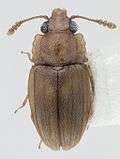Laemophloeidae
| Laemophloeidae | |
|---|---|
 | |
| Laemophloeus germaini | |
| Scientific classification | |
| Kingdom: | Animalia |
| Phylum: | Arthropoda |
| Class: | Insecta |
| Order: | Coleoptera |
| Suborder: | Polyphaga |
| Superfamily: | Cucujoidea |
| Family: | Laemophloeidae Ganglbauer, 1899 |
| Genera | |
|
Acompsophloeus Thomas, 2010 | |
| Wikispecies has information related to: Laemophloeidae |
Laemophloeidae, "lined flat bark beetles," is a family in the superfamily Cucujoidea characterized by predominantly dorso-ventrally compressed bodies, head and pronotal discs bordered by ridges or grooves, and inverted male genitalia.[1][2] Size range of adults is 1-5mm in length. Currently, it contains 40 genera and about 450 species,[3] and is represented on all continents except Antarctica; species richness is greatest in the tropics.
Historically, Laemophloeidae was treated as a subfamily of Cucujidae, but starting in the middle of the 20th century,[4] most of what had been treated as subfamilies of the Cucujidae were considered to be families.
Most laemophloeids, adults and larvae, are found under bark of dead trees, where they apparently are primarily fungivores,[5] although some genera with adults having subcylindrical bodies (e.g., Leptophloeus, Dysmerus) occur in the galleries of bark beetles (Curculionidae: Scolytinae), upon which they may feed.[6] A few genera, but most particularly Cryptolestes, contain some species that are pests of stored grain products. The most important of these are C. ferrugineus (Stephens), C. pusillus (Schönherr), and C. turcicus (Grouvelle).[7]
Several genera exhibit unusual modifications to male antennae (especially Cryptolestes, Dysmerus, and Microbrontes), with the scape expanded into hook-like or blade-like structures[8][9] Several other genera (Rhinomalus, Rhinophloeus, and Metaxyphloeus) related to Laemophloeus are atypical in that the adults are rostrate to varying degrees[10] Photographs of most world genera are available at,[11] and most North American species are pictured at,[12]
 Odontophloeus sp.
Odontophloeus sp. Phloeolaemus hoplites.
Phloeolaemus hoplites. Dysmerus symphilus.
Dysmerus symphilus. Metaxyphloeus germaini.
Metaxyphloeus germaini. Lepidophloeus exquisitus.
Lepidophloeus exquisitus.
References
- ↑ Thomas, M.C. 2002. Family 83. Laemophloeidae Ganglbauer 1899. Pp. 331-334 In: Arnett, R. H., Jr., M. C. Thomas, P. E. Skelley, and J. H. Frank (editors). 2002. American Beetles. Vol. 2. Polyphaga: Scarabaeoidea through Curculionoidea. CRC Press, Boca Raton. xiv + 861pp.
- ↑ Thomas, M. C., and R.A.B. Leschen. 2010. Laemophloeidae, Ganglbauer, 1899. p. 376-380. In: Leschen, R.A.B., R.G. Beutel, and J.F. Lawrence. Coleoptera, Beetles. Vol. 2: Morphology and Systematics (Elateroidea, Bostrichiformia, Cucujiformia partim). Handbook of Zoology. Walter de Gruyter, Berlin.
- ↑ Laemophloeidae Species List at Joel Hallan’s Biology Catalog. Texas A&M University. Retrieved on 15 May 2012.
- ↑ Crowson, R.A. 1955. The natural classification of the families of Coleoptera. Nathaniel Lloyd, London, 187pp.
- ↑ Lawrence, J.F. 1977. Coleoptera associated with an Hypoxylon species (Ascomycetes: Xylariaceae) on oak. Coleopterists Bulletin 31:309-312.
- ↑ Thomas, M.C. 1993. The flat bark beetles of Florida (Laemophloeidae, Passandridae, Silvanidae). Arthropods of Florida and Neighboring Land Areas 15: i-viii and 1-93.
- ↑ Halstead, D.G.H. 1993. Keys for the identification of beetles associated with stored products-II. Laemophloeidae, Passandridae and Silvanidae. Journal of Stored Product Research 29(2): 99-197.
- ↑ Lefkovitch, L.P. 1958. Unusual antennal characters in some Laemophloeinae (Coleoptera: Cucujidae) and their taxonomic importance. Proceedings of the Royal Entomological Society, London (B) 27:93-100.
- ↑ Thomas, M. C. 2009. A review of the genus Dysmerus Casey (Coleoptera: Laemophloeidae). Insecta Mundi 0074: 1-30.
- ↑ Thomas, M.C. 1984. A new Neotropical genus and species of rostrate Laemophloeinae (Coleoptera: Cucujidae), with discussion of the systematic position of the subfamily. Coleopterists Bulletin 38:67-83.
- ↑ Photographic Atlas of Laemophloeid Genera Retrieved 31 January 2014
- ↑ Laemophloeidae of Florida Retrieved 31 January 2014